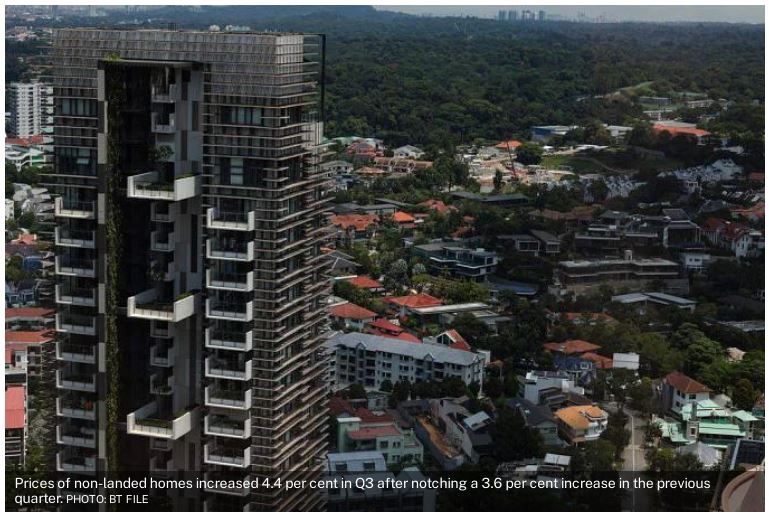Singapore: Private home prices rose 3.8% in Q3, up 8.2% this year
PRIVATE home prices in Singapore grew by 3.8 per cent in Q3 2022, accelerating from 3.5 per cent in Q2 and higher than the 3.4 per cent flash estimate by the Urban Redevelopment Authority (URA) earlier this month.
Between January and September, prices of private homes expanded by 8.2 per cent, highlighted Leonard Tay, head of research at Knight Frank. Tay added: “(They) look set to end the year with a gain of more than 10 per cent, despite the challenges of the cooling measures and rising interest rates.”
The increase in Q3 was led by prices of non-landed homes, which saw an increase of 4.4 per cent in Q3 after notching a 3.6 per cent increase in the previous quarter. By region, prices of non-landed homes in the outside central region (OCR) saw the biggest jump at 7.5 per cent, thanks to major launches AMO Residence, Lentor Modern and Sky Eden@Bedok, all of which saw brisk sales. The median price of units sold at those projects in Q3 were all above S$2,100 per square foot (psf).
In comparison, prices of non-landed homes in the OCR rose 2.1 per cent in Q2.
In the core central region (CCR), prices of non-landed homes increased by 2.3 per cent in Q3, versus 1.9 per cent in Q2, while in the rest of central region (RCR), prices went up 2.8 per cent, slowing from 6.4 per cent in the previous quarter.
Meanwhile, prices of landed properties edged up 1.6 per cent, compared with the 2.9 per cent growth in the previous quarter.
In late September, the government rolled out fresh property cooling measures to rein in demand and ensure prudent borrowing, including for HDB resale flats.
Lee Sze Teck, senior director (research) at Huttons, noted that the narrowing price gap between the CCR and RCR has resulted in more buyers snapping up homes in the CCR. “As of Q3 2022, the estimated median psf of new homes in the RCR stands at S$2,431, which is 13.5 per cent lower than the median psf in the CCR. Developers sold 562 units in the CCR in Q3, despite launching only 240 units for sale”.
Meanwhile, sales volumes declined for both new home sales and in the resale market in the face of rising interest rates and higher prices.
Resale deals accounted for 60.5 per cent of all private homes sold in the third quarter. They numbered 3,719 units, down from 4,236 units transacted in the second quarter. Developers sold 2,187 private homes (excluding executive condominiums or ECs), as new sales volumes eased 8.8 per cent quarter-on-quarter, and launched 1,455 units for sale, down from 1,956 units in the previous quarter. No EC units were launched for sale in Q3, although developers moved 28 EC units that quarter.
The rental market remained buoyant as rents of private homes increased 8.6 per cent in Q3, versus 6.7 per cent in the previous quarter, in what analysts say is the fastest pace of growth since Q3 2007. Rents of landed properties shot up 10.9 per cent, compared with a 3.2 per cent increase in the previous quarter, while rents of non-landed properties rose 8.3 per cent. In Q2, rents of non-landed homes went up 7.1 per cent.
With this, rents have jumped 20.8 per cent in the first nine months of this year, according to Knight Frank. “Rents in the private residential market will continue to increase in the remainder of 2022 and into 2023,” said Tay, pointing to the re-opening of borders, new policies to lure professional talent as well as locals on the hunt for replacement homes as factors supporting the market. In addition, the latest cooling measures saw the introduction of a 15 month wait-out period for those downgrading from private homes to HDBs, which will prompt some to turn to the rental market.
Christine Sun, OrangeTee & Tie’s senior-vice president of research & analytics, said: “For investors and landlords, surging rents are still cushioning the impact of higher mortgage payments now. If mortgage rates continue to soar and competition stiffens with more home completions next year, some landlords may face difficulty coping with the higher mortgage loans”. Higher property taxes and the rising cost of living may exacerbate the situation, she added.
At the end of the quarter, there was a total supply of 49,384 uncompleted private residential units (excluding ECs) in the pipeline with planning approvals, compared to 48,836 units in the previous quarter. Of these, 15,677 units remained unsold at the end of Q3, versus 15,805 units in Q2.
After adding the supply of 5,706 EC units in the pipeline, there were 55,090 units in the pipeline with planning approvals. Of the EC units in the pipeline, 2,060 units remained unsold. In total, 17,737 units with planning approvals (including ECs) remained unsold.
According to the URA, 3,619 units (including ECs) will be completed in the last quarter of this year, with another 20,098 units slated for completion in 2023.
The URA said: “Around 28,800 units (including ECs) are expected to be completed in 2022 and 2023, which is close to three times the 10,400 units completed in 2020 and 2021. This will help to cater to housing needs in the immediate term”.
More supply with planning approval, totalling around 31,400 units as at Q3 2022, will be completed beyond 2023.
Lee expects private home prices to grow by a more moderate one to two per cent in Q4, although he expects full-year price growth to clock between 9 and 10 per cent.
Sun said: “Fundamentals – such as our strong household balance sheets, tight domestic labour market and sustained income growth – will continue to prop up housing demand. While rising mortgage rates and prices are squeezing buyers, some will continue to purchase homes before interest rates rise further”.
Source: https://www.businesstimes.com.sg/real-estate/private-home-prices-rose-38-in-q3-up-82-this-year


 English
English




